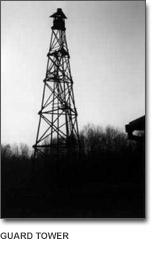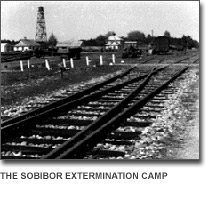|
| ||||||
 |
|

The proceedings of the extermination followed two scripts: for Polish Jews already aware of Sobibor's true function, their treatment from arrival to their death in the gas chambers was cruel, accompanied by shots, killing on the spot for the slightest resistance, beating and terror.
The foreign Jews not aware of their fate were threatened with deceptive care, even politeness, until the doors of the gas chamber.
The following description of the fate of a typical Dutch transport of 2,500 Jews will help you understand how millions could be killed so easily.
Excerpts from Thomas Blatt's diary describe the arrival of a Dutch transport:
"...The arriving passenger train stopped outside the camp at the small, obscure station amidst a wild forest. Inside, every available seat was taken.
Soon eight to ten cars were detached from the rest and pushed onto a sidetrack leading into the camp. The Germans and the Ukrainian guards were posted around the platform and waiting (1). At the Nazis' signal, people were ordered to alight.
After leaving the heavy luggage behind on the train platform, a column of about 500 people started towards a long barrack (31) with large gates on opposite ends. Attached to the right side of the barrack were smaller barracks (32). When they entered they were ordered to leave any handbags they still carried. The moment the barrack was empty, prisoners called "pakettentragers" (package carriers) opened doors to the adjoining barracks (32), and quickly transferred all the handbags to be sorted. The purses were emptied onto tables and the contents were thrown in the proper containers: money with money, brushes with brushes, lipsticks with lipsticks, etc. Finally, documents, pictures and other papers were taken in blankets to the incinerator.
While this was happening, the victims were led to a yard with an overhanging roof (33). There SS Scharfuehrer Herman Mitchell in a quiet, convincing voice, welcomed the Jews. He sympathetically apologized for the inconvenience of the trip and the difficulty in extending them a roof and a bed to relax in right away. First he explained, because of strict sanitary conditions, they must shower and be disinfected. Later, he assured them the able-bodied would work, get paid and live with their families until the war was won. The soothing speech of the well-mannered SS man had its effect.

The women and children brought in first, undressed and proceeded through the narrow alley between barbed wire fencing towards three connected barracks 100 meters away (45 ). There a group of prisoners, ironically called "friseurs" (barbers) by the Nazis, were waiting to cut their hair. It was done quickly with a few nervous clips of the scissors. The young girls, visibly ashamed, sometimes begged the "barbers" not to cut too short. They were certain a shower would follow. A German stood in the middle of the room with a whip in his hand, supervising and making sure the "barbers" would not speak to the victims. It was not necessary. The poor victims would not have believed them anyway. Now robbed of all their possessions, even their hair, the Nazis prepared to take their lives. The gas chambers were only four yards away. And soon they walked innocently to its open gates to be brutally packed into the gassing units (51).
SS Bauer and a Ukrainian named Emil started the engine (52) and soon a horrifying mass scream could be heard. At first it was very loud and spontaneous. About five minutes later it gradually subsided until finally a contrasting silence took over.
The next ten cars of people, by this time, were on route to the yard for the speech and surely heard the cries. But mixed with the roar of the engine and muffled by the thick walls of the gas chamber, it sounded from distance like thunder. Only the prisoners, their hearts frozen in terror, knew the truth.
Before piling the bodies on the pyres (55), the gold teeth were pulled by the "dentist" and other body cavities were searched for more possessions, all with restless speed.
Now, the victims dead, the prisoners finished sorting out the clothing. First, they removed the Star of David and checked every fold for hidden valuables. Then they packed them in lots of ten tying with string and stored them in huge warehouses (44) to be sent later. Simultaneously, the hills of private documents, diplomas, pictures, etc. were being burned in a specially built incinerator (46), removing the last traces of their existence. Thus, the destruction of a transport of Jews was completed. The people killed, the goods stored, the documents destroyed... as if, IT NEVER WAS."